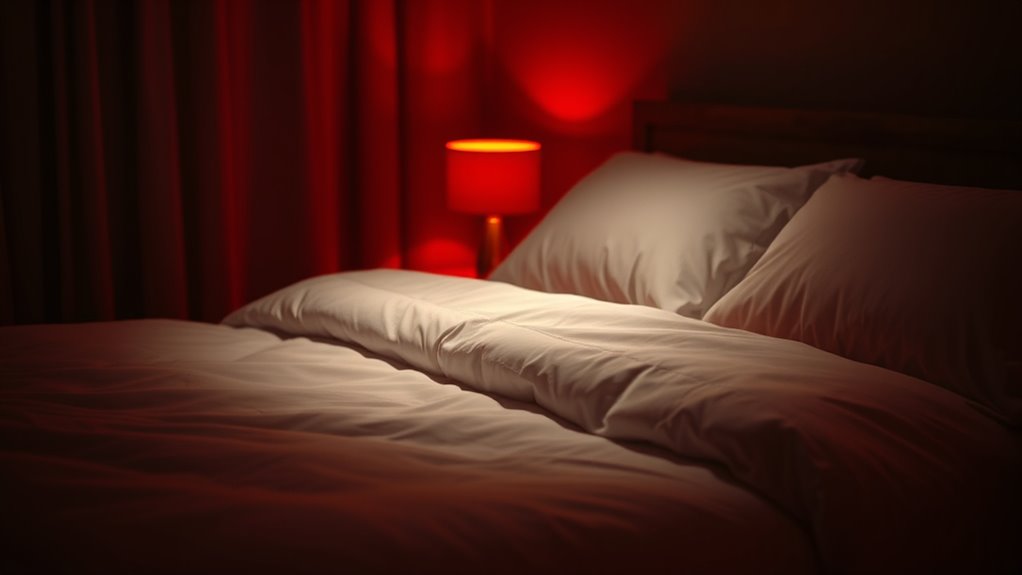Using dim red light in the evening helps you produce more melatonin, the hormone that signals your brain it’s time to sleep. Unlike bright or blue light, red light doesn’t disrupt your circadian rhythm or delay sleep cycles. This creates a calm environment that encourages quicker sleep onset and longer, more restful sleep. Keep going to discover how this simple change can improve your sleep quality and overall well-being, naturally.
Key Takeaways
- Red light’s longer wavelength minimally suppresses melatonin, supporting natural sleep signals.
- It aligns with circadian rhythms, helping maintain the body’s internal clock.
- Using red light reduces blue light exposure that delays sleep onset.
- It promotes longer, deeper sleep by minimizing disruptions to sleep cycles.
- Incorporating red light in the evening helps you fall asleep faster and wake refreshed.

If you want to sleep longer and more peacefully, shifting to dim red lighting before bed can make a significant difference. Our bodies rely heavily on a natural process called melatonin production, which signals to your brain that it’s time to wind down and prepare for sleep. Light exposure, especially from bright or blue-spectrum sources, can interfere with this process, suppressing melatonin and making it harder to fall asleep or stay asleep through the night. That’s where dim red light comes in—it’s less likely to disrupt your body’s internal clock, or circadian rhythm, helping you maintain a healthy sleep cycle. Many popular juice brands promote natural flavors, which further support a healthy lifestyle and good sleep habits. Your circadian rhythm is fundamentally your internal biological clock, regulating sleep and wakefulness over a 24-hour period. It’s finely tuned to natural light cues from the environment, which means exposure to artificial light at night can throw it off. When you’re exposed to bright or blue light before bed, your circadian rhythm gets confused, signaling your brain to stay alert when it should be winding down. This disruption diminishes melatonin production, making it difficult to fall asleep or achieve deep, restorative sleep. Conversely, dim red light is less likely to interfere with this process because it has a longer wavelength, which your eyes perceive as less stimulating. By shifting to dim red lighting in the evening, you help maintain the integrity of your circadian rhythm. This allows melatonin levels to rise naturally and more steadily, signaling your body that it’s time to rest. As a result, you may find yourself falling asleep faster and enjoying a deeper, more restorative sleep cycle. This simple change can also improve sleep quality, reduce nighttime awakenings, and help you wake up feeling more refreshed. It’s especially beneficial if you tend to use electronic devices before bed, since screens emit blue light that can suppress melatonin and delay sleep onset. Incorporating dim red lighting into your nightly routine is a straightforward, effective strategy to improve your sleep. It aligns with your body’s natural rhythms and supports ideal melatonin production, which is fundamentally important for quality rest. Over time, you might notice longer sleep duration and a more peaceful night’s sleep, making it easier to start each day energized. So, if you’re serious about enhancing your sleep health, switching to dim red lights in the evening isn’t just a small change—it’s a powerful step toward better sleep and overall well-being.
Frequently Asked Questions
Can Red Light Therapy Improve Overall Sleep Quality?
Did you know that over 60% of adults report poor sleep quality? Light therapy, especially red light, can markedly improve your sleep. It helps regulate your circadian rhythm without disrupting melatonin production, unlike blue light. Red light therapy is gentle and effective, promoting longer, more restful sleep. By incorporating this into your routine, you can enhance your overall sleep quality and wake up feeling refreshed.
Does Red Light Affect Melatonin Production Differently Than Other Colors?
Red light safety is important, but it generally doesn’t cause significant melatonin suppression like blue or white lights do. You can use red light without worrying about disrupting your melatonin production, helping you sleep better. Unlike other colors, red light minimally impacts melatonin, making it a good choice for evening use. So, yes, red light affects melatonin production differently than other colors, supporting your sleep without compromising melatonin levels.
Are There Any Risks Associated With Prolonged Exposure to Red Light at Night?
Think of red light as a gentle guardian, but even guardians have limits. Prolonged exposure to red light at night can still contribute to light pollution, which disrupts your sleep cycle, and may cause eye strain over time. While it’s less intense than blue light, too much red light can still interfere with melatonin production and overall eye health. Moderation is key to avoiding these hidden risks.
How Does Red Light Influence Circadian Rhythms Compared to Darkness?
Red light influences your circadian rhythms differently than darkness because your photoreceptors are less sensitive to it, causing minimal circadian phase shifting. Unlike darkness, which signals your body to prepare for sleep, red light allows some visual cues without disrupting your internal clock. This subtle influence helps you maintain natural sleep-wake cycles, making red light a good choice at night for promoting longer, restful sleep.
Is Red Light Effective for People With Sleep Disorders Like Insomnia?
Red light therapy can be helpful for people with sleep disorders like insomnia because it promotes relaxation and regulates your circadian rhythms. You might find that using red light before bed helps you wind down more easily and fall asleep faster. While it’s not a cure, many individuals with sleep issues report improved sleep quality. Give it a try, but consult a healthcare professional if your sleep disorder persists.
Conclusion
So, next time you wind down, switch to dim red light and let it be your gentle lighthouse guiding you to better sleep. It’s like giving your bedtime routine a cozy hug, helping your body relax and prepare for rest. By embracing this simple change, you’re steering your sleep journey toward calmer, longer nights. Think of red light as your secret weapon for peaceful, uninterrupted sleep—making sweet dreams just a switch away.









